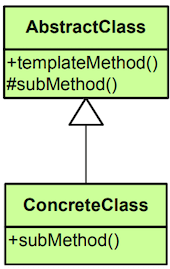[디자인 패턴] 행동 패턴 5. 템플릿 메서드 (Template Method)
Table of Contents
템플릿 메서드 (Template Method) #

- 부모 클래스에서 알고리즘의 골격을 정의하고, 해당 알고리즘의 구조를 변경하지 않고 자식 클래스들이 알고리즘의 특정 단계들을 오버라이드(재정의) 할 수 있도록 한다.
개념적인 예시 #
// 추상 클래스
abstract class AbstractClass
{
// 알고리즘의 뼈대를 정의한다.
public void TemplateMethod()
{
this.BaseOperation1();
this.RequiredOperations1();
this.BaseOperation2();
this.Hook1();
this.RequiredOperation2();
this.BaseOperation3();
this.Hook2();
}
// 이 동작들은 이미 구현되어 있다.
protected void BaseOperation1()
{
Console.WriteLine("AbstractClass says: I am doing the bulk of the work");
}
protected void BaseOperation2()
{
Console.WriteLine("AbstractClass says: But I let subclasses override some operations");
}
protected void BaseOperation3()
{
Console.WriteLine("AbstractClass says: But I am doing the bulk of the work anyway");
}
// 이 동작들은 자식 클래스에서 구현해야 한다.
protected abstract void RequiredOperations1();
protected abstract void RequiredOperation2();
// 훅(Hook)은 아무것도 하지 않는 구상 메소드를 부모 클래스에 정의하고,
// 자식 클래스에서 필요에 따라 재정의하여 사용하는 것이다.
protected virtual void Hook1() { }
protected virtual void Hook2() { }
}
// 자식 클래스들은 추상 클래스의 추상 메서드들을 오버라이드해서 구현한다.
class ConcreteClass1 : AbstractClass
{
protected override void RequiredOperations1()
{
Console.WriteLine("1-1");
}
protected override void RequiredOperation2()
{
Console.WriteLine("1-2");
}
}
class ConcreteClass2 : AbstractClass
{
protected override void RequiredOperations1()
{
Console.WriteLine("2-1");
}
protected override void RequiredOperation2()
{
Console.WriteLine("2-2");
}
protected override void Hook1()
{
Console.WriteLine("2-Hook1");
}
}
class Client
{
// 클라이언트는 추상 클래스의 템플릿 메서드를 호출한다.
public static void ClientCode(AbstractClass abstractClass)
{
// ...
abstractClass.TemplateMethod();
// ...
}
}
class Program
{
static void Main(string[] args)
{
Client.ClientCode(new ConcreteClass1()); // 1-1, 1-2
Client.ClientCode(new ConcreteClass2()); // 2-1, 2-2, 2-Hook1
}
}